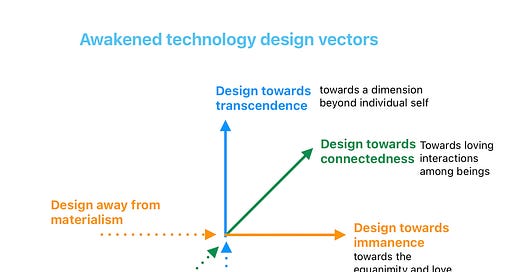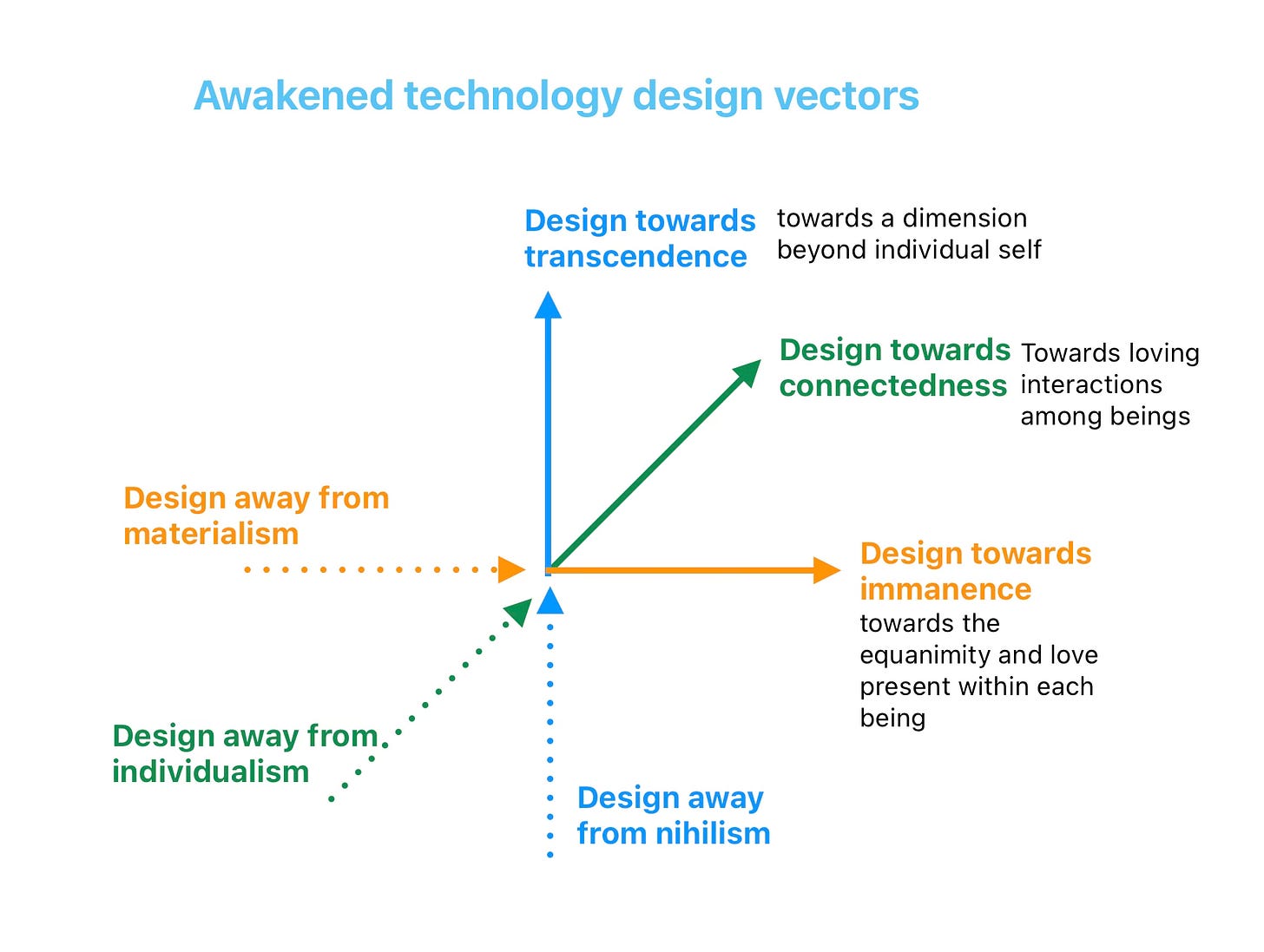What would an awakened approach to technology design look like?
The X, Y, and Z where technology and spirituality can meet
[T]he cultivation of spirituality might be essential if we are to avoid a tech-fuelled pandemic of stress, dissociation, and domination. -Gabriel Fernandez-Borsot, Spirituality and technology: a threefold philosophical reflection (2023), p. 19.
Part 1/4: Introduction
This is the first in a series of four posts where I will explore the conceptual intersections of technology and spirituality, and how they might give birth to a fruitful reframing of the other. I am heavily indebted to Professor Gabriel Fernandez-Borsot’s thought-provoking article on the topic (cited above), but I will attempt to make his observations more accessible to readers working in technology.
As an output, I propose a design framework aimed at inspiring a more spirituality-conscious approach to (technology) design.
In the following posts in the series I will look at the axes individually, adding detail, but before that, let’s establish the context.
Technology as human agency through science
In his article about the intersections of technology and spirituality, Fernandez-Borsot suggests that we should approach technology and its qualities on two levels:
First, there is how humans apply abstract knowledge into building technology. The knowledge is based on science that has helped us to understand the laws of nature (via physics, mathematics, chemistry, etc.), predict how nature behaves, and apply that into the operation of machines, devices, and / or infrastructure. Technology is developed through human agency.
Technology tends to gain a certain agency of its own via infusing “a mindset in those who design, produce, and use technological creations”:
This mindset predisposes the designers, producers, and users to certain attitudes, interpretations, and ways of solving problems. Thus, technology configures a certain “stance,” a way of being in the world. — Fernandez-Borsot, p. 10.
Such a way of being in the world leads technologists to embed moral values into their creations, knowingly or unknowingly.
Now, how can we create something practical out of acknowledging the above?
The corresponding two levels in spiritual traditions
The two levels — application of knowledge and the embedding of moral values into outputs — are helpful to reconcile something meaningful about the relationship of technology and spirituality. This is because each spiritual tradition also promotes certain ethos that influence its followers’ attitudes and behaviours; their ways of being in the world.
I have written about the meaning of spirituality in previous posts. Therefore, it suffices to summarise ‘spirituality’ here as the innate human need and birthright “to reach beyond the limits of ordinary human existence that is bounded by unconscious forces and self-interest” to cite Maya Spencer. Or, in neuroscientist Lisa Miller’s words, “Spirituality is an inner sense of relationship to a higher power that is loving and guiding.” (The Awakened Mind: Psychology of Spirituality).
If we believe, as Fernandez-Borsot suggests, that technology has an indirect agency, influenced by the world views of its makers, then that agency can also be influenced by spiritual views (or lack thereof) that technologists harbour.
The three axes
For Fernandez-Borsot, transcendence, immanence, and relationality represent the three axes where interactions between world views and agency occur. Mapping the coordinates on each axis sheds light on what those interactions between technology and spirituality are and can be.
In practice, in the translation work into an design approach I am getting at here, mapping the axes means identifying the coordinates on each axis and how naming those coordinates can help in driving design towards transcendence, immanence, and relationality (or connectedness, which I find a more accessible term.)
Importantly, the axes do not point only from spirituality to technology, but also the other way around. Fernandez-Borsot submits that the axes help “to shed light on shadow aspects of technology that spirituality may help identify and even remedy, and on inadvertent aspects of spirituality that technology brings to view.“ (Fernandez-Borsot, p. 7.)
By doing this, we avoid polarised views, namely seeing technology as completely antithetical to spiritual practices, or seeing it as the vanguard for humanity’s spiritual evolution. Fernandez-Borsot argues that building and developing technologies are deep enough human activities to be connected to spirituality, whilst spirituality in its own right can “orient and balance technological development”.
Towards awakened technology design
While Fernandez-Borsot’s analysis sets the philosophical ground for a more nuanced approach to technology development and spirituality’s contribution to it, I propose that a more tangible translation for technologists is needed. Design theories, also in the context of technology, need to be normative to be applicable. If remaining descriptive, such theories do not establish directions that are clear enough to assist in making practical design choices.
Approaches such as value-sensitive design are helpful in supporting technologists and designers in deliberating the implicit and explicit values their creations might reflect. Other frameworks around responsible innovation and research provide tangible concepts — such as equitability and trustworthiness — that are, by raising ethical concerns during the design process, useful in attempts to mitigate harm . However, to my knowledge, there is no framework that includes any spiritual aspects or a spiritual dimension.
Therefore, I propose the following tentative model for inspiring technology design practices. The model aims to inspire technology designs, or design in general, towards certain qualities and phenomena that reflect spiritual aspects, and away from qualities that typically prevent individuals and collectives to embrace spiritual paths towards moral outcomes.
Please note the current illustration is a high-level summary of the approach. In the following posts of the series, I will introduce specific coordinates on the axes, unpacking how the ‘vectors’ can be understood as movement from, for example, enabling selfishness to enabling self-sacrifice, or from privileging hedonism to embracing equanimity.
As the saying goes, “all models are wrong, but some are useful.” While the following posts in the series will delve deeper into my rationale behind the model , I fully acknowledge that it is up for debate. Also, I cannot say I have put it into practice - yet! Going forward, I would like to learn about the model’s usefulness through practice.
Thank you for reading. As always, I leave you with a piece of contemplative algorithmic art:
With love and kindness,
Aki
Unexamined Technology is a reader-supported resource for re-examining one’s relationship to technology. The best way to support my work is by sharing it with others, and considering to become a paid subscriber and . Thank you! -Aki







I'm really looking forward to how you develop these ideas. I had not heard of Fernandez-Borsot before, so that was a welcome discovery inside of an already welcome discovery (viz. your essay).
Very curious diagram -- thank you for this!